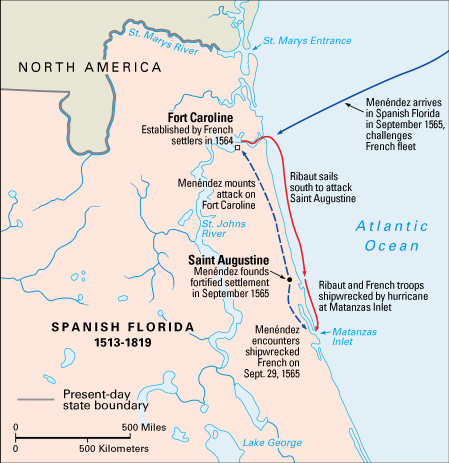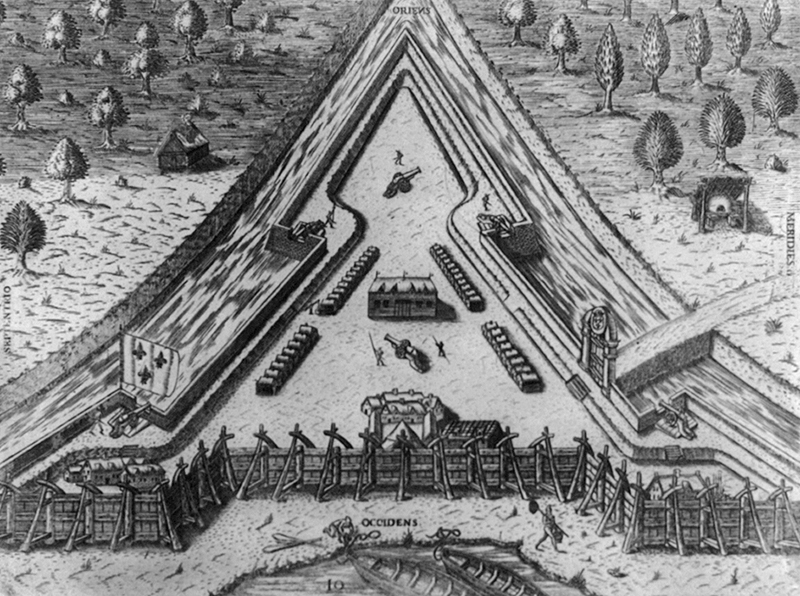Matanzas Massacre was an incident in 1565 in which Spanish soldiers killed more than 200 French colonists in Florida. The Spanish were led by General Pedro Menéndez de Avilés. The massacre took place near what is now Matanzas Inlet in northeastern Florida. The inlet earned its name—Spanish for _slaughters—_as a result of the incident.
Background.
In 1513, the Spanish explorer Juan Ponce de León arrived in Florida and claimed the land for Spain. Later Spanish expeditions further explored Florida, but the Spanish had difficulty starting settlements there.
In 1562, French settlers led by Jean Ribaut explored the St. Johns River in northeastern Florida, and Ribaut claimed the area for France. The French then headed north and established a short-lived settlement in what is now South Carolina. Two years later, another group of French settlers returned to the St. Johns River. The settlers established Fort Caroline near present-day Jacksonville. In 1565, Ribaut reinforced Fort Caroline with several hundred soldiers and colonists. Ribaut and many of the colonists were Huguenots (French Protestants).

In 1565, King Philip II of Spain selected Pedro Menéndez de Avilés to lead an expedition to Florida. Menéndez viewed the expedition as a commercial venture. The king also wanted Menéndez to colonize Florida for Spain. Menéndez and the Spanish were Roman Catholics. Shortly after Menéndez agreed to lead the expedition, the Spanish learned that the French had settled at Fort Caroline.

In September 1565, Menéndez’s ships arrived near Fort Caroline and challenged the French fleet. The French fleet withdrew, but it later returned to Fort Caroline to warn Ribaut. After chasing the French fleet, Menéndez founded the fortified settlement of Saint Augustine, about 15 miles (24 kilometers) south of Fort Caroline. St. Augustine is the oldest permanent settlement established by Europeans in what is now the United States.
Ribaut soon sailed south to attack St. Augustine, but his ships went off course in a hurricane. He and his men became shipwrecked south of St. Augustine. Ribaut had left some troops, most of whom were ill or wounded, along with women and children back at Fort Caroline.
After Ribaut and his ships were thrown off course by the hurricane, Menéndez led about 500 men in an attack on Fort Caroline. Menéndez’s men killed over 130 French troops and captured about 50 women and children. The women and children were later returned to France.
The massacre.
Indians warned Menéndez about the shipwrecked French south of St. Augustine. He then marched about 50 soldiers towards the French.
On September 29, Menéndez encountered a group of the shipwrecked French and urged them to surrender. He made no promise of sparing their lives. The French had lost most of their food and weapons and were in no condition to fight. The French surrendered. Menéndez then demanded that they convert to Catholicism. More than 100 French troops refused to convert and were executed. Menéndez spared a number of men who either claimed that they were Catholic or who had skills needed at St. Augustine.
About two weeks later, Menéndez encountered Ribaut and another group of shipwrecked French. They also surrendered to the Spanish. Ribaut and about 130 others were executed when they refused to convert to Catholicism. Again, Menéndez spared a few men.
Many people at St. Augustine and in Spain condemned Menéndez for his cruelty. Menéndez’s supporters defended his actions by claiming that he would have been unable to feed and control the prisoners without endangering the colonists at St. Augustine. The Spanish destruction of French forces ended French attempts to settle in eastern Florida.
See also Colonial life in Spanish America ; Florida (History) ; Menéndez de Avilés, Pedro ; Ribaut, Jean ; Saint Augustine .
